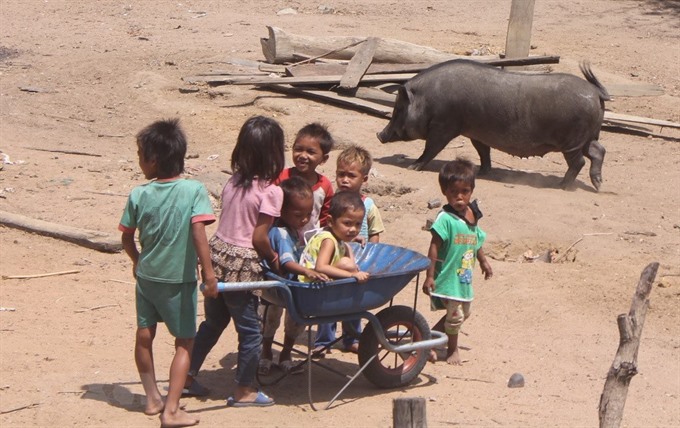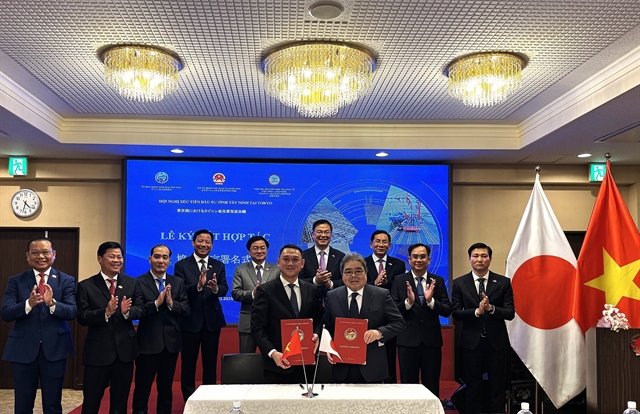 Society
Society

When the authorities of the Central Highlands province of Gia Lai decided to build the Ayun Hạ irrigation system in 2000, hundreds of local residents in Phú Thiện District’s Chư A Thai Commune were relocated to a new resettlement area.
 |
| Children play in a village in the Central Highland province of Gia Lai. Several of the children in the province are out of school since their families moved back to their villages from a resettlement area following the construction of the Ayun Hạ irrigation system. — VNA/VNS Photo Dư Toán |
GIA LAI — When authorities of the Central Highlands province of Gia Lai decided to build the Ayun Hạ irrigation system in 2000, hundreds of local residents in Phú Thiện District’s Chư A Thai Commune were relocated to a new resettlement area.
But 18 years later, many of them have returned to live in their old villages, despite the poor living conditions there. They refer to the ’five No’s’ in their village: no electricity, no roads, no schools, no health stations, and no future.
The 70 residents of the Heg Village are among those who left the resettlement area to return to their hometown. According to village head Đinh Jăi, after the completion of the irrigation system, some senior members of the village revisited the area where the village was once located, finding it remained intact, and decided to move back there.
Lying between the three mountains of Cheng Leng, Lờ Pá and N’Nheng, the Heg Village is accessible either by a boat ride across the Ayun Hạ Lake, or a 10km walk through a forest.
The distant, deserted village is not an ideal place for children to grow up. None of the local children – who are of the Banar ethnic minority – have been sent to school, taught the national language, or been vaccinated and provided with other social services.
Villagers have to go a long way to seek professional help when they get sick, because the village has no health station. They have three options: travelling 6km to neighbouring Chư Sê District, 8km to the resettlement area, or 15km to the Mang Yang District to see the doctors there.
“Such long journeys make it more difficult to save lives,” said village head Đinh Jăi. “Some of our people died because they couldn’t reach any health facilities in time.”
But none of them have any intention of leaving the village.
“This is our birthplace,” said Đinh Jăi. “We will cling onto it as long as we can.”
Located on top of the Cheng Leng Mountain is the Plei Cheng Leng Village of some 20 households; the oldest one has been there for over 20 years.
Similar to those in Heg Village, Plei Cheng Leng residents abandoned the resettlement area to return to their birthplace due to “the lack of agricultural lands at the new place”, said villager Rmah T’rúi.
But their dear village also lacks a resource essential for life: water.
“Life is rough here without water,” said Rmah T’rúi. “We never have enough water for farming, drinking, even for taking care of our personal hygiene.”
Living in isolation in the temporary, self-built houses between the Chư Sê and Phú Thiện districts, these villagers have no household registration or identity cards, and can’t enjoy any social welfare policies.
There is neither any electricity nor schools in sight, which dulls the future of local children. Some of them have reached their teenage years but are not able to read and write.
The provincial authorities are trying to persuade these villagers to return to the resettlement area, said Phùng Trung Toàn, chairman of the People’s Committee of Chư A Thai Commune.
“We are reviewing the number of households in an attempt to provide them with better management,” he said.
“We have decided to give part of the commune’s lands to those in need of farming lands,” he said, adding that they had done that once, before asking villagers to relocate to the resettlement area.
But it is such a difficult mission to ask these ethnic minority people to leave their hometowns again, Toàn added.
“Making a living farming on high mountains has been their custom for generations,” he said. — VNS




